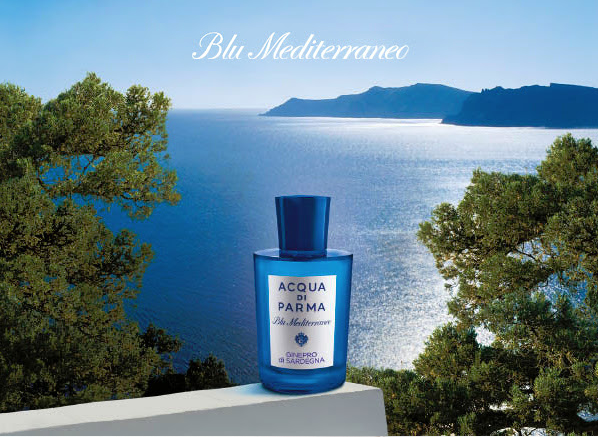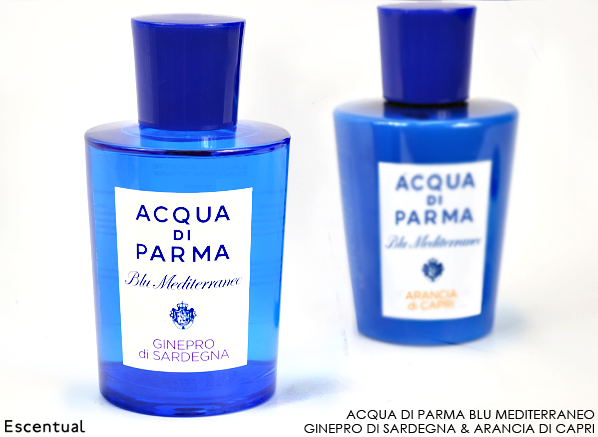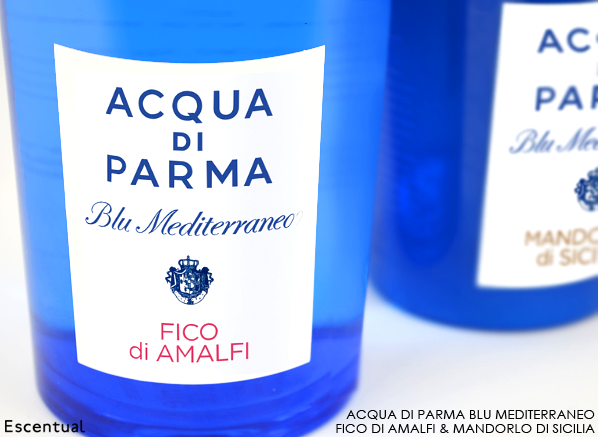

I don’t know about you but the recent bouts of sunshine sure have got me in the mood for all things summer. The sunglasses have been on, ice creams have been consumed and I’ve even rocked a pair of shorts, much to the dismay of those around me who do not wish to see my ghostly white pins. My fragrance choices have been lighter too and I’ve started to break out those big guns for summer that simply sing underneath the glory of the sun.
It’s at this time of year that one looks to the more exotic things in life and delves for those fragrances that speak of azure-coloured skies and the glistening white sparkle of languid seas. We take holidays to beautiful locations and our fragrances do the same with many brands offering a plethora of perfumes designed to take one away to somewhere more alluring than our everyday abodes.
Italian house Acqua di Parma is one such brand and with their Blu Mediterraneo collection, they send one’s nose on an olfactory journey across the beautiful scenes, skies and seas of the Mediterranean, soaking up the sights, sounds and smells that make for the DNA of the Italian way of life. From the sweet succulence of Amalfi figs to the sparkling bergamot of Calabria, the Blu Mediterraneo collection is awash with Italian splendour at every turn.
So grab your shades, crack open a bottle of fizzy San Pellegrino and sit back as we bask in the summer glory of Acqua di Parma’s Blu Mediterraneo collection.

Ginepro di Sardegna
Acqua di Parma’s latest addition to the line is a celebration of Sardinian juniper, the key ingredient in the much beloved (well, by me at least) substance that is gin. Now, Ginepro di Sardegna (as the fragrance is called) is not a straight-up rendition of an ice cold G&T (head for Penhaligon’s Juniper Sling if that’s what you’re after) but it does give the impression of cool gin carried on the wisps of salty sea air.
In the opening, Ginepro di Sardegna is bracing, rough and spicy. It smells herbal with a strong dose of black pepper providing angular edges to represent the spiky green leaves of the juniper tree. Underneath this jagged start lays a rocky mineral accord that is stitched to dense columns of spicy, warm and ever so slightly fuzzy, Virginian cedarwood.
Ginepro di Sardegna is a perfume that is evocative of Italy’s more rugged mountain landscapes. It presents freshness in a manner where the coolness of stone and the spiky quality of the natural flora appears refreshing, bracing and stimulating. Spray this on, close your eyes and imagine that you are hiking through the rocky Italian countryside.
Arancia di Capri
I do like a nice orange scent and Arancia di Capri is a very nice take on oranges, indeed. Strong citrus notes are always difficult in perfumery due to the natural ingredients being unstable, thus causing them to evaporate from the skin rapidly. It’s therefore a technical feat for a perfumer to create a robust and long-lasting citrus note. Arancia di Capri manages this quite well (well, sort-of).
The fragrance starts with a big squeeze of glistening orange juice, and we’re talking the good stuff here not your average bottle of Sunny Delight. This is premium, A grade, ‘I just twisted ten oranges to make a tiny amount of juice’ kind-of-stuff and whilst it lasts on the skin it is incredibly enjoyable. But the good things in life never last and before long the full ripeness of orange is all but a memory.
We shan’t lament the loss of orange though, as Arancia di Capri has a few tricks up its sleeve and slowly, but surely, it pulls out a wonderfully hay-like neroli note that is instantly reminiscent of the warm air trapped amongst a sea of orange trees – a grove of beautiful flowers and fruit, if you will. This effect does stick about thanks to the solidifying nature of musk and makes for a fragrance that is undemanding and joyful, if not a little bit frustrating.

Bergamotto di Calabria
Is there any smell on Earth more pleasant than the soft sparkle of fresh bergamot? I genuinely don’t think there is. The stuff is so good that it is possibly one of the most used ingredients in perfumery and Calabrian bergamot oil is considered to be the absolute best in the world. It’s also used in Earl Grey tea, which serves as further proof that it is awesome. So it stands to reason then, that a perfume based entirely on the idea of this wondrous ingredient would smell pretty fantastic and Bergamotto di Calabria certainly delivers.
Acqua di Parma’s ode to Italy’s yellow fruit is very much what one would expect from a bergamot fragrance. It captures every facet of the fruit perfectly, from the sparkling sherbet sweetness of the opening, to the more bitter lemon edge in the heart, before moving to a more lime-like tartness in the base. This fragrance is a big squeeze of bergamot and it smells simply delicious.
Bergamotto di Calabria isn’t all about bergamot though and as it dries down it gains an even more multi-faceted persona, diverging into waves of sharp ginger and dashes of smooth (and almost powdery) woods and musk. It would be difficult to find a bergamot fragrance that is more satisfying than this one and for that reason it should be considered as a summer staple for any lovers of the note or just citrus-based fragrances in general.
Fico di Amalfi
Figs are a weird fruit. Don’t get me wrong, they’re undeniably a blooming amazing fruit, but it would be silly to not acknowledge the fact that they are a bit odd with their tangy pulp, sticky seeds and general sense of puffy milky-ness. Acqua di Parma’s ode to fig, ‘Fico di Amalfi’, captures all of these facets in a perfume that is effortlessly wearable and not bizarre in any way, shape of form.
In Fico di Amalfi the fig feels very green but also incredibly nectarous, almost evoking the image of twigs and leaves covered in a sweet, honey-like sap. This contrast is explored further as the fragrance develops and as it gains that famous milky quality that makes figs so fascinating. The tension between the green notes and the lascivious honey ensures that the scent always verges on being just a little bit too sweet, but never tips over into cloying territory. It’s all a bit sexy, to be honest.
Fico di Amalfi is a satisfying fig fragrance and it very easily holds it own against other phenomenal figgy scents, such as Diptyque’s Philosykos (pure fig tree, including the fruit, leaves and bark) and Mugler’s Womanity (fig shortbread from Mars). It has a sun-kissed feel to it that’s almost reminiscent of sunscreen, giving it a beachy vibe that paints the picture of beautifully oiled bodies basking on golden sands under the bright Mediterranean sun. Sounds pretty good, doesn’t it?

Mandorlo di Sicilia
Of course, Italy isn’t just about stunning landscapes and sparkling citrus fruits; it’s also a place with a rich food-loving heritage and is a country that produces some of the best gastronomy on the planet. To celebrate the foody side of Italian life there is a delightful tasty treat nestled amongst the figs, fruits, woods and azure bottles of the Blu Mediterraneo collection.
This marvellous little fragrance is called Mandorlo di Sicilia and it showcases the Italian love for the gourmand, specifically in the form of little almond biscuits and practically microscopic cups of coffee. But this is delicious sweetness in a wonderfully light and delicate manner, so If you’ve got the idea of a big, thick and completely oppressive gourmand monster in your head, then you could not be more wrong. This is a delicious fragrance that is aerial enough to be considered as entirely summer-appropriate.
Mandorlo di Sicilia opens with the anise vibrancy of bitter almond. It is quickly softened and sweetened by a subtle hint of cherry and the hot white petals of jasmine. At first it calls to mind a more diluted version of Christian Dior’s phenomenal Hypnotic Poison (one heck of a milky almond and jasmine perfume), but the Acqua di Parma feels outwardly edible with its dark underpinnings of bourbon vanilla and cappuccino foam, making for an instantly more Mediterranean feel. In short, it is damn good stuff.
Mirto di Panarea
When I think of Italy, I think of basil. Well actually, that’s not entirely true, when I think of Italy I think of Vespas, gelato and pizza, but for the sake of this review the delightful herb that is basil also enters my brain. There isn’t anything quite as enjoyable as a touch of pungent basil amongst the sweetness and softness of tomato and mozzarella (I’m willing to acknowledge that there is a lot of food talk going on here but I’m owning it). It’s an ingredient that cuts silently cuts through everything else to create contrast and it smells (and tastes) incredibly distinct.
In Mirto di Panarea, basil is the star player and in the first few moments one is presented with a photorealistic rendition of the herb, in all of its green, savoury glory. Before long a subtle, but sour twist of lemon joins the foray to soften the harder edges of the basil, but for the most part Mirto di Panarea remains aromatic all the way through, throwing out balmy hints of juniper, mastic and lilac.
Mirto di Panarea fits very nicely into the Blu Mediterraneo collection simply because it provides a much needed contrast to the vibrancy of the other, mainly citrus-based perfumes. It creates a nice little niche that is evocative of wild grasses and fresh salads, and serves as an entirely different type of freshness that sits perfectly amongst the other perfumes in the collection.
The Verdict
Acqua di Parma’s Blu Mediterraneo collection is a fascinating olfactory tour of Italy from the breath taking landscapes to the fruits and foods that make for such an irresistibly beautiful culture. Whether you are looking for some citrus sparkle, wearable almond milk or even a hit of gin caught in the sea air, this collection of Italian-inspired perfumes is not to be missed. In fact, it is to be explored from sea to sea (or bottle to bottle) and seen as an olfactory education of all that makes the Mediterranean so good and great. Now can someone please put me on a plane to Italy?!




